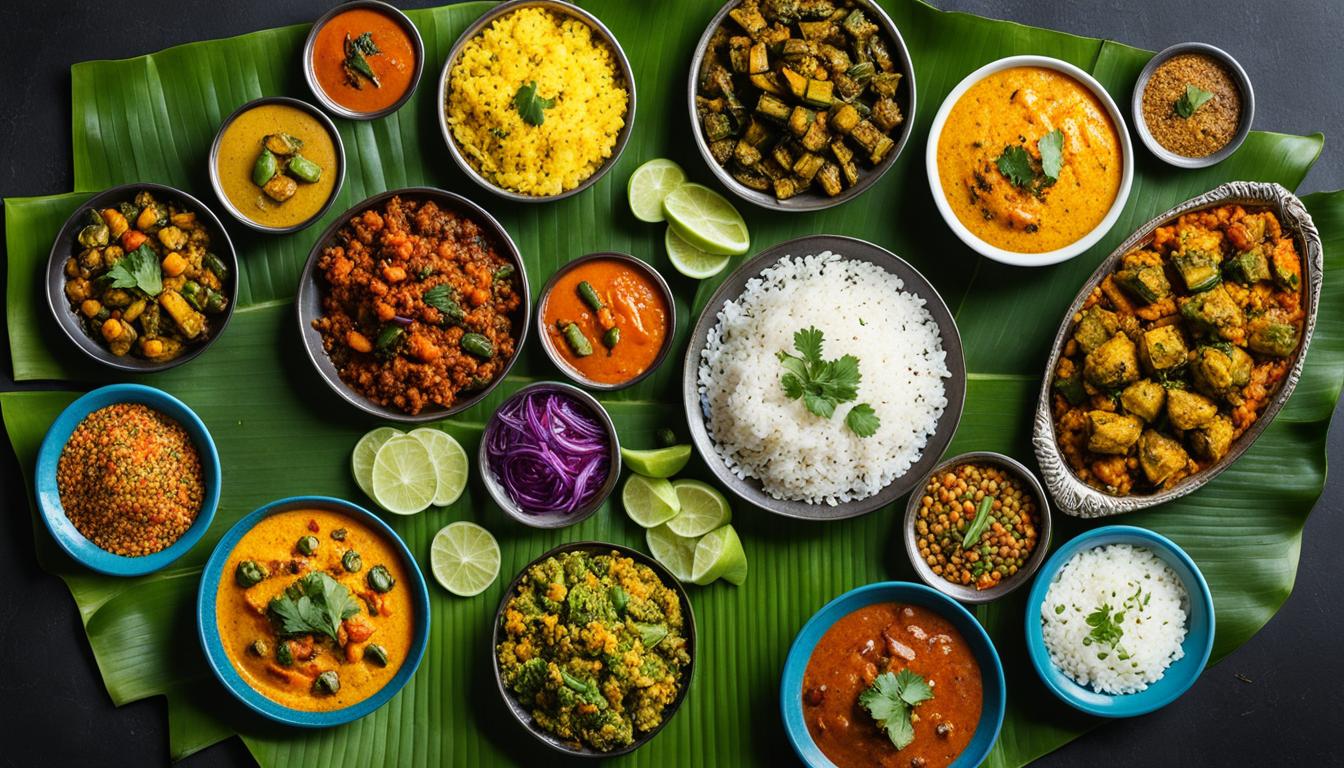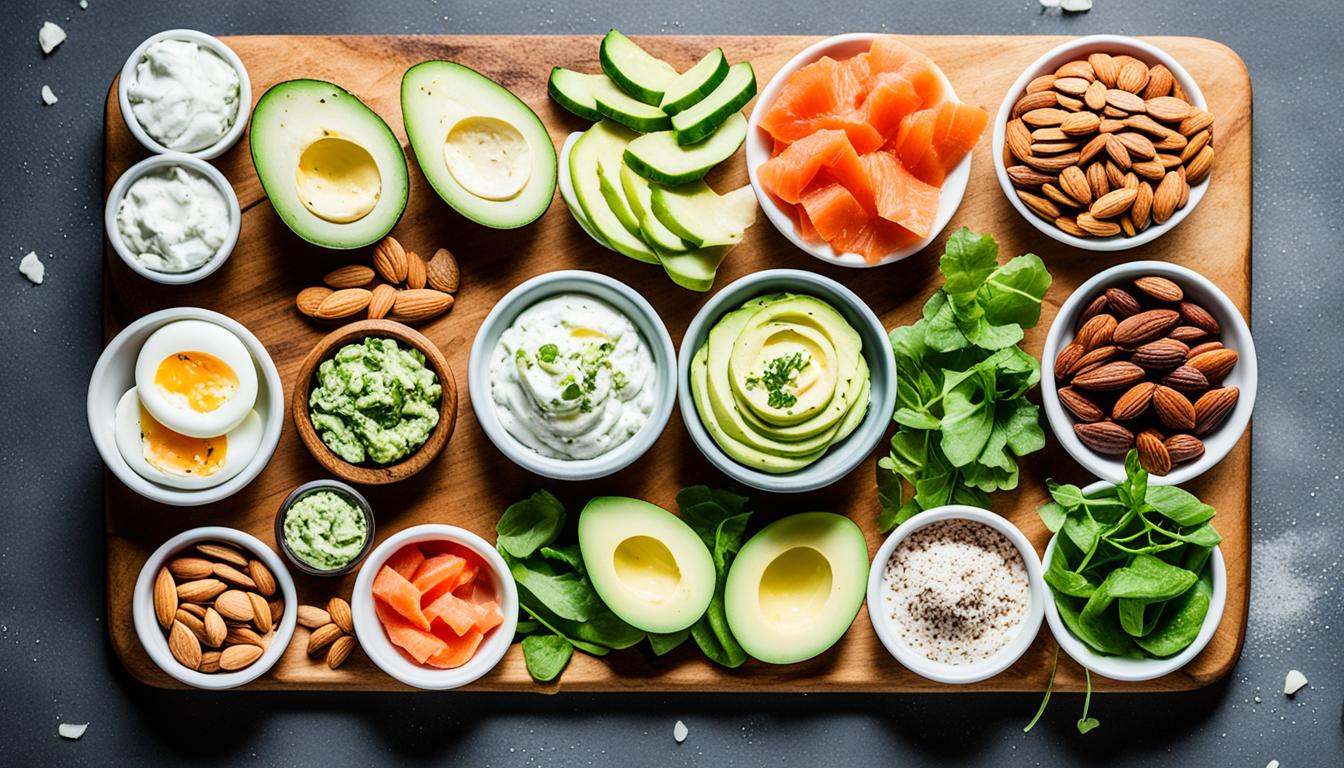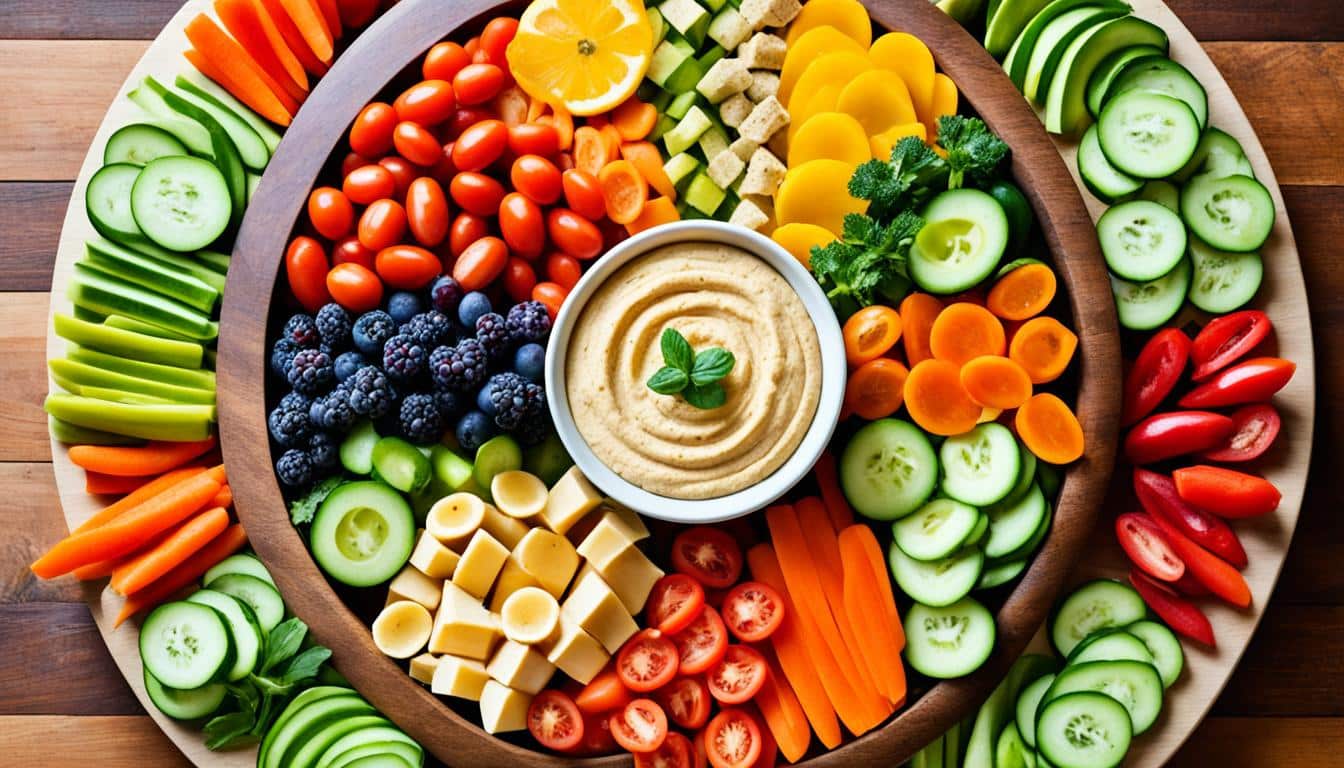Indian cuisine is a harmonious blend of flavors, vibrant colors, and aromatic spices. Among the diverse range of options, vegetarian Indian cuisine stands out for its delicious offerings and numerous health benefits.
Vegetarian Indian recipes celebrate the abundance of plant-based ingredients, making it a haven for those seeking wholesome and nutritious meals. From hearty lentil dishes and vegetable curries to fragrant rice preparations and spicy chutneys, the possibilities are endless in the world of vegetarian Indian cooking.
Key Takeaways:
- Vegetarian Indian cuisine offers a wide array of flavorful and nutritious dishes.
- Indian vegetarian recipes incorporate a variety of vegetables, lentils, legumes, and spices.
- Traditional vegetarian Indian dishes are prepared using less oil and creams, making them a healthier choice.
- Vegetarian Indian restaurants provide a range of options suitable for different tastes and dietary preferences.
- Exploring the world of vegetarian Indian cuisine allows you to experience the authentic flavors of India while nourishing your body with wholesome ingredients.
Ayurvedic Principles and Mindful Eating in Indian Culture
Ayurveda, an ancient system of medicine originating in India, holds a pivotal role in Indian culture. It emphasizes the importance of a balanced diet and mindful eating for overall health and well-being. Ayurvedic principles recognize that each individual has a unique constitution and recommends specific foods and herbs to promote balance and harmony in the body.
Mindful eating is a core aspect of Ayurveda, encouraging people to be present in the moment and pay attention to the qualities of food. By doing so, one can enhance digestion and absorption of nutrients, leading to better overall health. Mindful eating involves savoring each bite, chewing food thoroughly, and being aware of hunger and satiety cues.
“When walking, walk. When eating, eat.” – Zen Proverb
In Indian culture, mealtimes are seen as an opportunity for nourishment and connection. Families often eat together, offering a sense of unity and community. This practice not only promotes mindful eating but also allows for the sharing of food and experiences, strengthening bonds.
Ayurvedic principles also emphasize the importance of a balanced diet, tailored to an individual’s unique constitution or dosha. The doshas, known as Vata, Pitta, and Kapha, represent different combinations of elements and qualities within the body. Each dosha requires specific foods and lifestyle practices to maintain balance.
| Dosha | Characteristics | Recommended Foods |
|---|---|---|
| Vata | Air and ether elements | Warm, grounding foods like cooked grains, root vegetables, and nourishing oils. |
| Pitta | Fire and water elements | Cooling foods like cucumber, cilantro, coconut, and sweet fruits. |
| Kapha | Earth and water elements | Spicy, stimulating foods like ginger, garlic, cinnamon, and light grains. |
By following the principles of Ayurveda and mindful eating, individuals can not only nourish their bodies but also promote overall well-being. The holistic approach to food and lifestyle in Indian culture fosters a deep connection between nutrition and health.
Ayurvedic principles and mindful eating in Indian culture offer valuable insights into maintaining a balanced diet and promoting overall wellness. By being mindful and attentive to our food choices, we can foster a deeper connection with our bodies and the nourishing qualities of Indian cuisine.
Ingredients that Make Indian Food Healthy
Indian cuisine is renowned for its rich flavors and vibrant colors, but did you know that it also offers a host of health benefits? Let’s explore the key ingredients that make Indian food a nutritious choice.
Lentils and Legumes: Lentils and legumes, such as chickpeas and mung beans, are staples in Indian cooking. They are rich in plant-based protein, fiber, vitamins, and minerals, making them a valuable addition to a balanced diet.
Spices: Spices play a crucial role in Indian cuisine, not only for enhancing the taste but also for their potential health benefits. Ginger, turmeric, cumin, and hing (asafoetida) are commonly used spices that have anti-inflammatory properties and can aid in digestion.
Protein Sources: While Indian cuisine offers a plethora of vegetarian options, it also includes various protein-rich choices for meat lovers. From succulent chicken dishes to flavorful curries made with tofu or paneer (cottage cheese), there are plenty of protein options to suit diverse dietary preferences.
Whole Grains: Whole grains like whole wheat, millet, and rice are dietary staples in India. They provide a good source of fiber, B vitamins, and minerals, promoting overall health and maintaining energy levels.
Vegetables: Indian dishes are known for their generous use of vegetables, whether it’s crispy okra, spiced potatoes, or vibrant spinach curries. Vegetables are packed with essential nutrients, fiber, and vitamins, making them a vital component of a healthy meal.
“The combination of lentils, legumes, spices, protein sources, whole grains, and vegetables in Indian cuisine creates a harmonious balance of flavors and nutrition.”
Benefits of Indian cuisine:
- Provides plant-based protein and fiber
- Offers anti-inflammatory properties
- Includes protein-rich options for vegetarians and meat lovers
- Supplies essential nutrients from whole grains
- Packs a variety of vegetables for added vitamins and minerals
By incorporating these ingredients into your diet, you can enjoy the delicious flavors of Indian cuisine while nourishing your body with a diverse range of nutrients.
| Ingredient | Health Benefits |
|---|---|
| Lentils and Legumes | Rich in protein, fiber, vitamins, and minerals |
| Spices (ginger, turmeric, cumin, hing) | Anti-inflammatory properties, aid in digestion |
| Protein Sources (meat, poultry, tofu, paneer) | Provides essential amino acids and supports muscle growth |
| Whole Grains (whole wheat, millet, rice) | Good source of fiber, B vitamins, and minerals |
| Vegetables | Loaded with essential nutrients, fiber, vitamins |
Benefits of Indian Food for Immunity
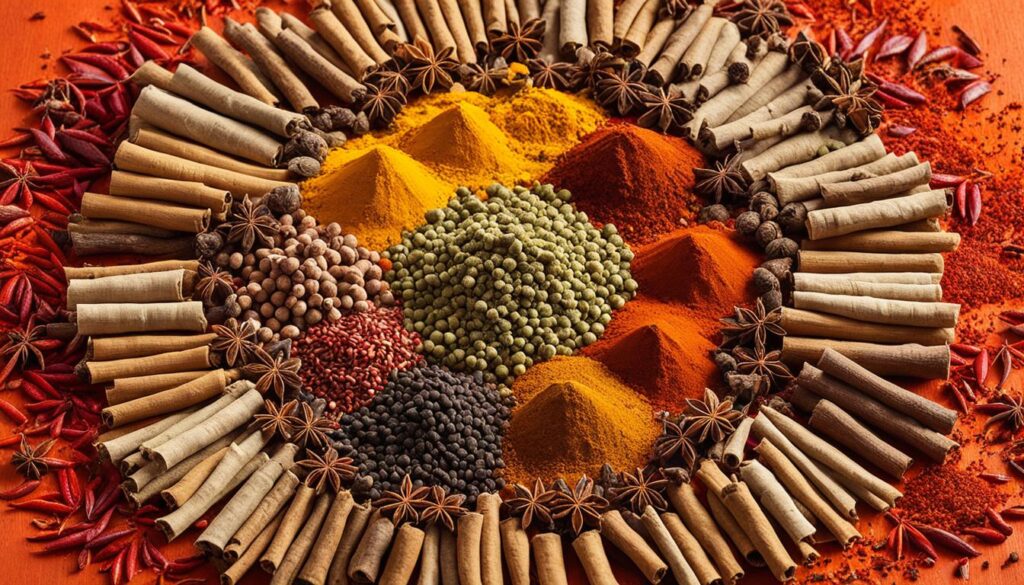
Indian cuisine is not only known for its delicious flavors but also for its potential health benefits, especially when it comes to boosting the immune system. This is attributed to the incorporation of various herbs and spices that have immune-boosting properties.
One of the key ingredients used in Indian cooking is garlic. Garlic is known for its antimicrobial, antiviral, and immune-enhancing properties. It contains a compound called allicin, which boosts the production of white blood cells and enhances immune response.
Cinnamon, another commonly used spice in Indian cuisine, is rich in antioxidants. It has anti-inflammatory properties and can help protect against various diseases. Cinnamon also contains natural antimicrobial agents that can fight against bacteria and viruses.
Cardamom, with its aromatic and distinctive flavor, is not only used as a spice but also as a natural remedy in Ayurveda. It has antimicrobial properties and can boost the immune system. Additionally, cardamom is believed to have antioxidant and anti-inflammatory properties.
Clove, a commonly used spice in Indian cooking, has long been valued for its medicinal properties. It is rich in antioxidants and can help boost the immune system. Clove also has antimicrobial properties and can help fight against infections.
By incorporating these herbs and spices into your meals, you can enjoy not only the delicious flavors but also the potential immune-boosting benefits they provide.
Immune-Boosting Herbs and Spices
| Herb/Spice | Benefits |
|---|---|
| Garlic | Antimicrobial, antiviral, immune-enhancing |
| Cinnamon | Anti-inflammatory, antioxidant, antimicrobial |
| Cardamom | Antimicrobial, immune-boosting, antioxidant, anti-inflammatory |
| Clove | Antioxidant, immune-boosting, antimicrobial |
By incorporating these flavorful herbs and spices into your dishes, you can add not only depth of flavor but also potential immune-boosting properties to your meals. Try experimenting with different combinations to create unique and healthy recipes that nourish both your taste buds and your immune system.
Healthier Cooking Methods in Indian Cuisine
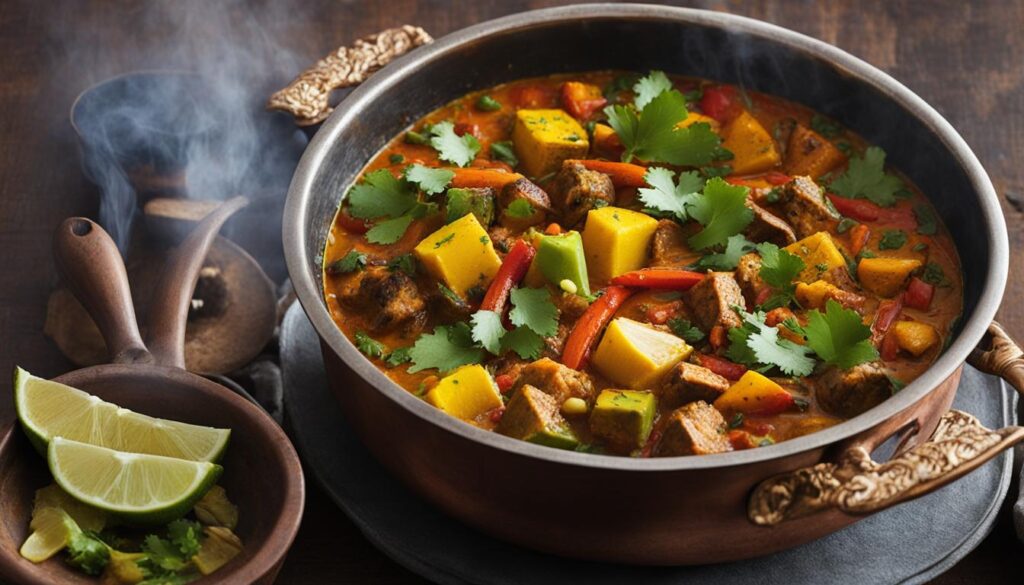
Indian cuisine is known for its diverse cooking methods that bring out the rich flavors and aromas of the dishes. While some cooking techniques in Indian cuisine may involve deep frying, it is important to note that this method does not represent the entire culinary tradition. In fact, Indian cooking incorporates a variety of healthier cooking methods that help retain the nutrients in the ingredients.
One popular cooking method in Indian cuisine is simmering. This involves cooking the ingredients in a liquid, such as water, broth, or sauce, over low heat for an extended period of time. Simmering allows the flavors to meld together and infuse into the dish, resulting in a rich and flavorful outcome.
Sautéing is another commonly used cooking method in Indian cuisine. It involves quickly cooking the ingredients in a small amount of oil or ghee over high heat. This method helps to develop the flavors and textures of the ingredients while preserving their nutritional value.
Slow cooking, or cooking over a low flame for an extended period of time, is also prevalent in Indian cuisine. This method is especially popular for dishes like curries and stews, as it allows the flavors to intensify and the ingredients to become tender.
By incorporating healthier cooking methods like simmering, sautéing, and slow cooking, Indian cuisine maintains the nutritional integrity of the ingredients while delivering delicious and flavorful meals. These cooking methods contribute to the overall healthiness of Indian food, making it a great choice for those seeking a nutritious and satisfying culinary experience.
Portion Sizes and Indian Food
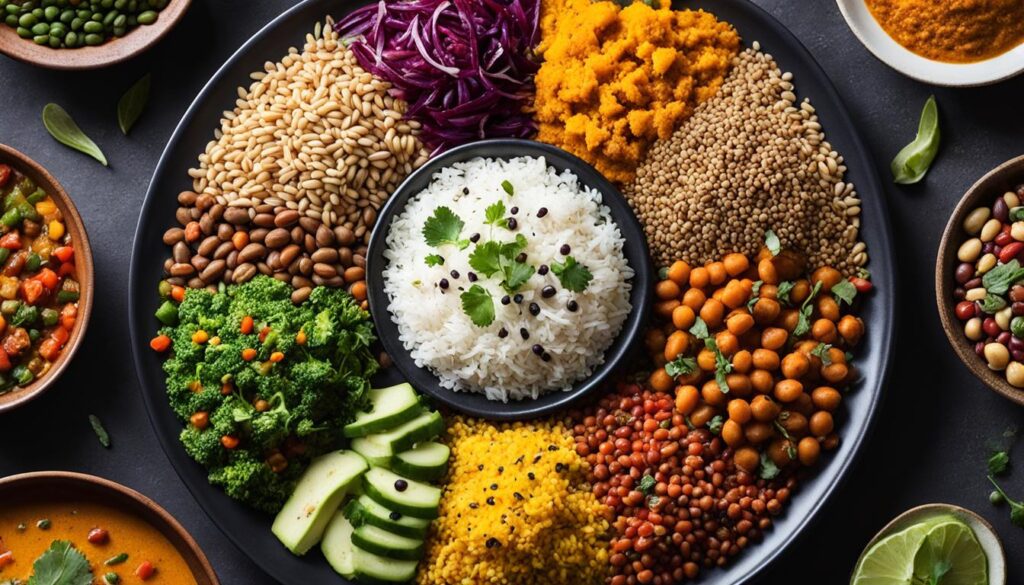
When it comes to enjoying Indian cuisine, portion sizes play a crucial role in maintaining a healthy balance. Indian meals are often served in a family-style manner, with multiple dishes placed in the center of the table for sharing. This not only encourages a sense of togetherness but also promotes portion control and smaller servings of each dish to avoid overeating.
This family-style serving style allows everyone to have a taste of different flavors and dishes without consuming excessive amounts of food. It also fosters a sense of community and enjoyment as everyone shares and savors the different offerings on the table.
It’s essential to be mindful of portion sizes, especially as some Indian dishes can be calorie-dense due to the use of ingredients like butter and ghee. By opting for smaller portions, you can still satisfy your cravings while keeping your calorie intake in check.
Enjoying Indian meals in family-style portions promotes portion control.
Calorie-Dense Indian Dishes
While Indian cuisine offers a wide array of flavorful and nutritious dishes, some can be calorie-dense due to the generous use of ingredients like butter, ghee, and oils. These dishes are indulgent and delicious but should be enjoyed in moderation to maintain a healthy diet and lifestyle.
Here are a few examples of calorie-dense Indian dishes:
| Dish | Calories per Serving |
|---|---|
| Butter Chicken | 500 |
| Pakoras | 300 |
| Puri (Fried Indian Bread) | 180 |
| Paneer Tikka | 350 |
| Gulab Jamun | 150 |
While it’s perfectly fine to enjoy these dishes occasionally, it’s essential to exercise portion control and balance them with healthier options.
By being mindful of portion sizes and opting for smaller servings, you can still indulge in the flavorful world of Indian cuisine while maintaining a healthy and well-balanced lifestyle.
Plant-Based Options in Indian Cuisine

Indian cuisine offers a wide range of plant-based options, making it suitable for vegetarians and vegans. The inclusion of plant-based ingredients in Indian dishes not only provides a variety of flavors but also ensures a wholesome and nutritious meal. Lentils, legumes, vegetables, and whole grains are the key components of plant-based Indian meals, offering a plethora of essential nutrients.
Lentils and legumes, such as chickpeas and mung beans, are commonly used in Indian cooking to add protein, fiber, vitamins, and minerals to the diet. These ingredients make plant-based Indian meals not only nutritious but also satiating.
Vegetables play a vital role in Indian cuisine, providing a myriad of flavors, textures, and nutrients. From hearty curries with a medley of vegetables to crispy and savory snacks like pakoras, Indian cuisine offers a diverse selection of vegetarian options. Whether it’s the classic aloo gobi (potato and cauliflower curry) or the vibrant baingan bharta (roasted eggplant mash), Indian vegetarian dishes are bursting with flavor and nutritional value.
Whole grains like rice, wheat, millets, and quinoa are staples in Indian cuisine, serving as a wholesome base for many dishes. These grains provide fiber, complex carbohydrates, vitamins, and minerals, contributing to a well-rounded plant-based meal.
Benefits of Plant-Based Indian Meals:
Choosing plant-based Indian meals has several benefits:
- Nutritional richness: Plant-based ingredients like lentils, legumes, and vegetables offer a wide range of nutrients, including protein, fiber, vitamins, and minerals.
- Heart-healthy: The emphasis on whole grains and plant-based protein sources in Indian cuisine promotes heart health by reducing the intake of saturated fats and cholesterol.
- Weight management: Plant-based meals can be lower in calories and high in fiber, aiding in weight management and promoting satiety.
- Reduced environmental impact: Opting for plant-based meals helps reduce the environmental footprint by conserving resources and reducing greenhouse gas emissions associated with animal agriculture.
By choosing plant-based options in Indian cuisine, individuals can enjoy flavorful and nutritious meals that support their dietary preferences and overall well-being.
| Dish | Main Ingredients |
|---|---|
| Chana Masala | Chickpeas, tomatoes, onions, spices |
| Pav Bhaji | Mixed vegetables (potatoes, peas, bell peppers, etc.), spices, butter |
| Palak Paneer | Spinach, paneer (Indian cottage cheese), tomatoes, onions, spices |
| Dal Makhani | Black lentils, kidney beans, tomatoes, onions, cream, spices |
| Aloo Tikki | Potatoes, peas, spices |
Healthy Tips for Indian Cooking
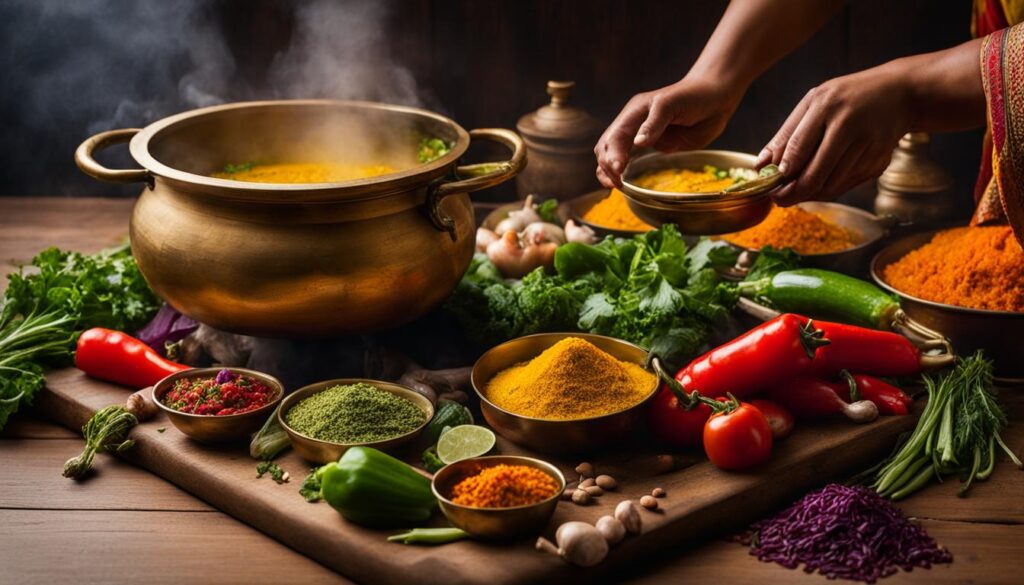
When it comes to Indian cooking, there are several healthy tips and alternatives that can help you create flavorful and nutritious dishes. By making simple ingredient substitutions and applying healthier cooking techniques, you can enjoy the delicious flavors of Indian cuisine while maintaining a balanced diet. Here are some tips to get you started:
1. Opt for Tomato-Based Curries
Instead of heavy cream-based curries, try using tomato-based sauces. Tomatoes are rich in antioxidants and vitamins, providing a healthy and vibrant base for your curries. They also add a tangy flavor that complements a variety of spices and ingredients.
2. Explore Vegetable Dishes
Vegetable dishes are a fantastic way to incorporate healthy ingredients into your Indian meals. Load up on a colorful array of vegetables such as carrots, bell peppers, spinach, and cauliflower, which are rich in vitamins, fiber, and minerals. These veggie-packed dishes are not only nutritious but also bursting with flavors.
3. Choose Lean Protein Sources
Opt for lean protein sources like fish or chicken instead of heavier options like lamb or beef. Fish, such as salmon or tilapia, are packed with omega-3 fatty acids and offer a healthier alternative. Skinless chicken breast is another great lean protein option that can be marinated and cooked in various Indian spice blends for a burst of flavor.
4. Substitute Healthier Oils
Avoid excessive use of oils and fats, such as ghee, and choose healthier alternatives like olive oil or coconut oil. These oils are lower in saturated fats and offer additional health benefits. Using these oils in moderation can help reduce the overall calorie content of your dishes.
5. Try Low-Fat Alternatives
Incorporate natural yogurt instead of cream or coconut milk in your sauces. Yogurt adds creaminess and tang without the excessive fat content. Similarly, you can experiment with low-fat coconut milk or almond milk to achieve a rich and creamy texture in your curries.
6. Enhance Flavor with Healthy Techniques
In Indian cooking, there are various techniques to enhance flavor without adding extra calories. One such technique is frying cumin seeds, known as a tadka, in a small amount of oil or ghee. The process releases the aromatic oils from the cumin, infusing the dish with a smoky and nutty flavor.
7. Add Fresh Salads or Chutneys
Complete your Indian meals with fresh salads or chutneys made with healthy ingredients. A side salad with mixed greens, cucumbers, cherry tomatoes, and a squeeze of lemon adds a refreshing element to your meal. Chutneys made with herbs, mint, coriander, or tamarind are also great accompaniments that can elevate the overall nutritional value of your Indian dishes.
The Health Benefits of Indian Street Food
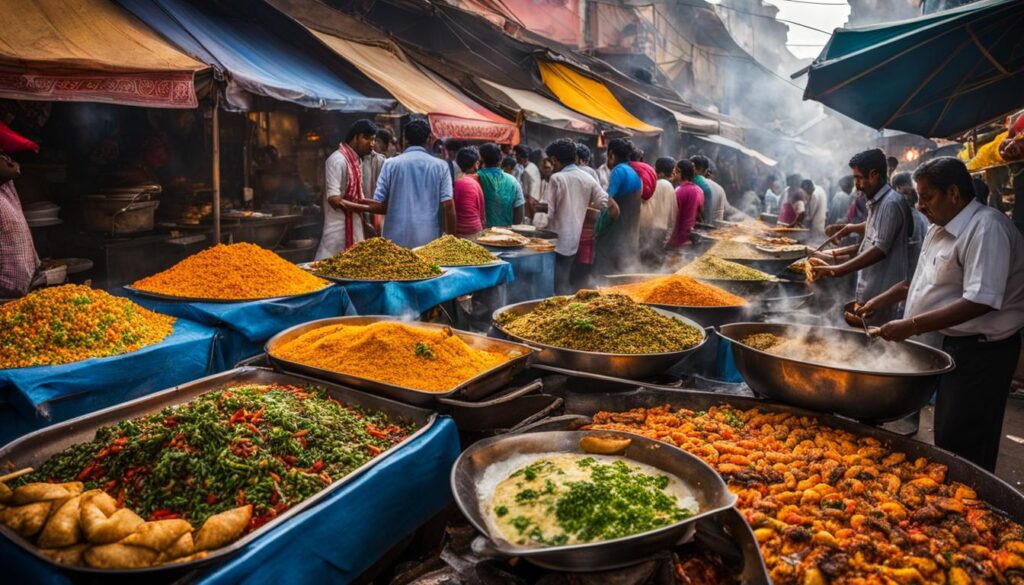
Indian street food is renowned for its vibrant flavors, bold spices, and mouthwatering snacks. One of the most popular street food genres in India is chaat, a collection of savory snacks typically served on the streets or in small food stalls. Not only is Indian street food incredibly delicious, but it also offers a wide range of health benefits.
Chaat snacks, despite their indulgent reputation, can be made using wholesome ingredients that are packed with nutrition. Many chaat recipes feature a variety of vegetarian options, making them an ideal choice for those following a vegetarian or vegan diet. Lentils, vegetables, and whole grains are frequently incorporated into these snacks, providing essential nutrients, fiber, and vitamins.
The spices used in Indian street food not only enhance the flavors but also offer numerous health benefits. Spices like turmeric, cumin, and ginger are known for their anti-inflammatory properties and digestive benefits. These spices not only add a burst of flavor but also contribute to the overall nutritional value of the snacks.
However, it’s important to note that not all Indian street food options are equally healthy. Some snacks may be deep-fried or loaded with excessive fats and sugars. It’s essential to make informed choices and opt for healthier alternatives whenever possible.
Despite these considerations, Indian street food can still be enjoyed as part of a balanced diet. Incorporating these flavorful and nutritious snacks into your diet allows you to experience the diverse culinary heritage of India while reaping the health benefits of their wholesome ingredients.
“Indian street food is a gastronomic adventure that offers a myriad of flavors in every bite. From the tangy flavors of pani puri to the spicy goodness of aloo tikki, these snacks are a true celebration of India’s culinary diversity.” – Anika Sharma, Food Writer
Healthy Indian Recipes to Try
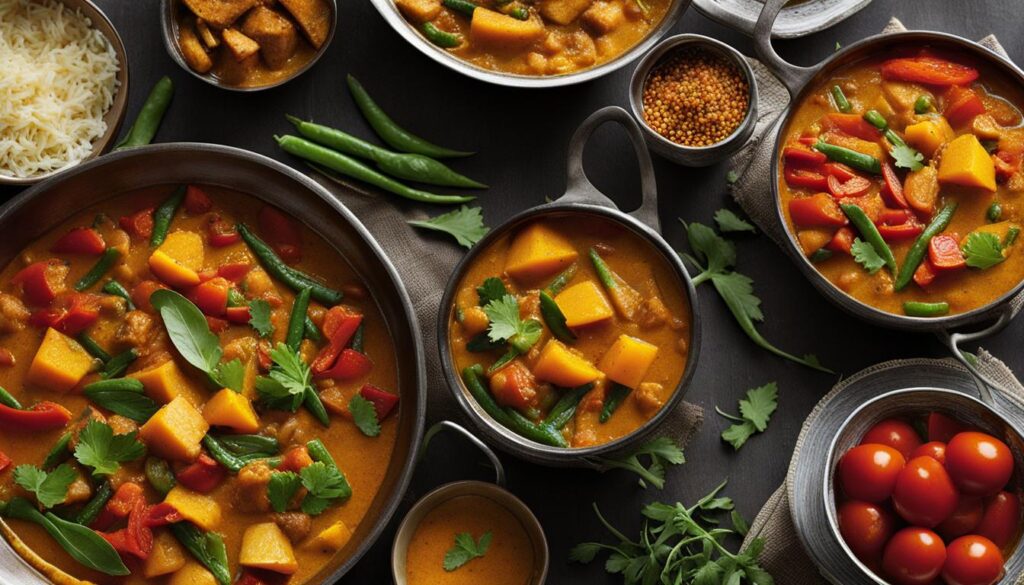
If you’re looking to incorporate the nutritious elements of Indian cuisine into your meals, there are plenty of healthy Indian recipes you can try at home. These recipes offer a delicious way to enjoy lentils, vegetable curries, and protein-packed meals.
Lentil Dishes
Lentils are a staple in Indian cooking and provide a good source of protein and fiber. Try making a hearty lentil soup or a flavorful dal, which is a lentil curry served with rice or bread. Lentil dishes are not only nutritious but also satisfying and comforting.
Vegetable Curries
Indian cuisine celebrates the use of a variety of vegetables in its dishes. Vegetable curries are a great way to incorporate different flavors and textures into your meals. From creamy paneer tikka masala to spicy aloo gobhi, there are countless vegetable curry recipes to explore.
Protein-Packed Meals
If you’re looking to add more protein to your diet, Indian cuisine offers a range of options beyond meat. Tofu and paneer, a type of Indian cheese, are commonly used in dishes like tikka masala and saag paneer. These protein-packed ingredients can be substituted for meat in many Indian recipes.
By trying out these healthy Indian recipes, you can indulge in the flavors of Indian cuisine while fueling your body with nutritious ingredients. Don’t be afraid to experiment and adapt the recipes to suit your dietary preferences. Enjoy the vibrant and delicious world of Indian cooking!
Conclusion
Vegetarian Indian cuisine is not only delicious but also offers numerous health benefits. With its wide range of flavors, the use of aromatic spices, and healthy cooking techniques, vegetarian Indian dishes are both flavorful and nutritious. By incorporating the principles of Ayurveda, such as mindful eating and a balanced diet, individuals can fully enjoy the rich tastes of Indian food while promoting their well-being.
Whether you are a vegetarian or simply looking to explore new culinary experiences, vegetarian Indian cuisine provides a fantastic option for a balanced diet. The diverse array of ingredients, such as lentils, legumes, and vegetables, ensure that you receive essential nutrients like protein, fiber, and vitamins. The incorporation of immune-boosting herbs and spices further enhances the health benefits of this cuisine.
By making mindful choices in portion sizes and cooking methods, such as opting for simmering or sautéing rather than deep-frying, you can enjoy the mouthwatering flavors of Indian cuisine without compromising your health goals. Vegetarian Indian dishes are a great way to maintain a well-rounded and balanced diet, offering a flavorful alternative to meat-based meals.
In conclusion, vegetarian Indian cuisine is a fantastic option for those seeking a balanced and nutritious diet. Its diverse flavors, health benefits, and mindful cooking practices make it a popular choice in many households. Whether you are looking to try new dishes or enhance your vegetarian cooking repertoire, vegetarian Indian cuisine is sure to delight your taste buds while promoting your overall well-being.
Also Refer : Exploring The Diversity Of American Food And Cuisine
FAQs
Q: What is paneer and how is it used in Indian vegetarian cuisine?
A: Paneer is a fresh cheese commonly used in Indian cooking. It is often incorporated into dishes such as paneer tikka, palak paneer, and paneer masala.
Q: Can you suggest some popular Indian vegetarian recipes?
A: Some popular Indian vegetarian recipes include dal tadka, chana masala, vegetable biryani, and vegan korma.
Q: What are the main health benefits of consuming Indian vegetarian cuisine?
A: Indian vegetarian cuisine often includes a variety of legumes, vegetables, and spices, providing a rich source of nutrients, fiber, and antioxidants veg south indian,north indian, classic indian. It can contribute to a balanced diet and support overall health.
Q: What is the significance of dal in Indian vegetarian cuisine?
A: Dal, which refers to dried split pulses like lentils, peas, or beans, is a staple in Indian vegetarian cuisine comfort food. It is a good source of protein and is commonly prepared in various flavorful and aromatic dishes.
Q: What are some popular side dishes in Indian vegetarian cuisine?
A: Popular side dishes in Indian vegetarian cuisine include dishes like raita, mixed vegetable curry, or aloo gobi, which complement the main dishes and add variety to the meal.
Q: Are there any easy and quick Indian vegetarian recipes for beginners?
A: Yes, there are several easy and quick Indian vegetarian recipes suitable for beginners, such as simple dal paneer recipes, mixed vegetable stir-fries, or easy paneer dishes.
Q: What are some common spices and herbs used in Indian vegetarian cuisine?
A: Common spices and herbs used in Indian vegetarian cuisine include cumin, coriander, turmeric, garam masala, mustard seeds, curry leaves, and fenugreek, among others.
Q: How can I make crispy rice dishes in Indian vegetarian cuisine?
A: Crispy rice dishes, like vegetable biryani, can be made by layering parboiled rice with sautéed vegetables and aromatic spices, then cooking them together to achieve a crispy texture.
Q: Are there any popular Indian sweets that are vegetarian?
A: Yes, there are numerous vegetarian Indian sweets, such as gulab jamun, rasgulla, jalebi, and barfi, which are enjoyed as desserts or during festive occasions.
Q: How can I prepare vegan Indian dishes that are also gluten-free?
A: You can prepare vegan and gluten-free Indian dishes by using ingredients like chickpea flour, rice flour, or gluten-free grains, and ensuring that the spices and seasonings are also gluten-free.









